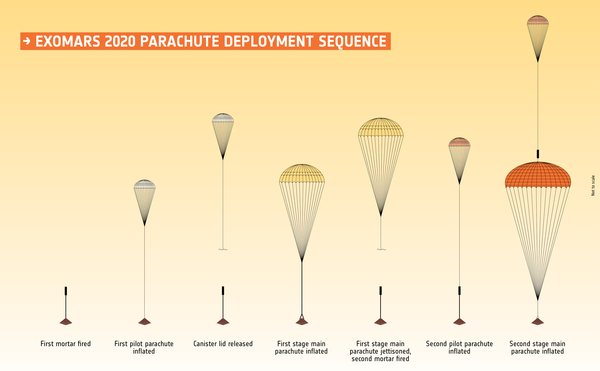ExoMars 2020: progress and challenges
28 June 2019
The full parachute system that will help deliver the ExoMars rover and a surface science platform to the martian surface has completed a full-scale high-altitude deployment sequence test, although unexpected damage to the main parachutes occurred. |
| ExoMars 2020 parachute deployment sequence. Credit: ESA |
Meanwhile, the main elements of the descent module hardware, including the heat shield that will protect the lander as it enters the atmosphere of Mars, have been delivered to Thales Alenia Space in Turin, Italy, this week. The European carrier spacecraft that will carry the mission from Earth to Mars, and the Russian landing platform named Kazachok already arrived in Italy earlier this year. The rover, named Rosalind Franklin, is currently being fitted with hardware and its scientific payload in Stevenage, UK. Once fully integrated, the hardware will be tested to ensure it is ready for the journey to space, and operations on Mars.
As part of the planned upcoming testing, the parachute system will be adjusted to address a problem observed in the most recent high-altitude drop test, conducted on 28 May at the Swedish Space Corporation Esrange facility in Kiruna.
The descent module needs two parachutes – each with its own pilot chute for extraction – to help slow the craft prior to landing. Following separation of the parachutes, the speed must be suitable for the braking engines to safely deliver the landing platform and the rover onto the surface of Mars. The entire sequence from atmospheric entry to landing takes just six minutes.
Last year the second and largest main parachute was successfully tested in a low-altitude drop test from an altitude of 1.2 km, deployed by a helicopter. The parachute has a diameter of 35 m, which is the largest parachute ever to fly on a Mars mission. The most recent test took place from a height of 29 km with the aid of a stratospheric helium balloon, and focused on the deployment sequence of all four parachutes.
A precise release of the drop test vehicle occurred at the planned altitude and the first pyrotechnic mortar activated normally to release the first pilot chute – which inflated correctly.
The main parachute lid release mechanism worked and the first main parachute also inflated well, but several radial tears in the fabric were observed immediately following extraction from the main parachute bag, before the parachute experienced maximum load.
The second pyrotechnic mortar also worked normally, ejecting the second pilot chute, which also inflated as expected. The second main parachute was extracted from its bag, but one radial tear was observed, again before reaching peak inflation loads.
All the data onboard the drop test vehicle were recovered and analysed. These data include acceleration, angular rates, magnetometer, GPS, and barometer data, together with camera footage.
Detailed analysis of the telemetry parameters recorded during the test confirmed that a good level of the expected aerodynamic drag was nevertheless achieved in spite of the parachute tears. The overall descent time of the entire test was also close to prediction.
The second parachute was quickly recovered and examined while it took a few days to identify and recover the first parachute that had travelled over 100 km following separation.
"Hardware recovery was essential to help define necessary improvements prior to the next test," says Francois Spoto, ExoMars team leader.
"We will implement design improvements to the parachute bags to ensure smoother extraction of the parachute, as well as reinforcements to the parachute itself to limit tear propagation in case some would still occur. The complex process of folding and packing the parachutes and hundreds of lines will also be examined."
Two further parachute tests are planned for later in 2019.
"Although the overall test sequence was successful, we always expected to encounter some problems while testing such a complex system," says Francois.
"This is why we test, test and test again, to overcome potential weakness and make sure we have the strongest system flying to Mars. We are working harder than ever to keep on track for our launch window next year."
The mission is scheduled for launch in July 2020, arriving at Mars in March 2021. After driving off the surface platform, Rosalind Franklin will explore the surface of Mars, seeking out geologically interesting sites to drill below the surface, to determine if life ever existed on our neighbour planet.
The ExoMars programme is a joint endeavour between ESA and Roscosmos. In addition to the 2020 mission, it also includes the Trace Gas Orbiter (TGO) launched in 2016. The TGO is already both delivering important scientific results of its own and relaying data from NASA's Curiosity Mars rover and Insight lander. It will also relay the data from the 2020 mission once it arrives at Mars.
For further information, please contact:
ESA Newsroom and Media Relations
Tel. +31 (0)71 565 6409
Email: media![]() esa.int
esa.int

